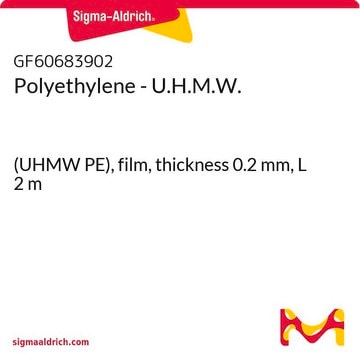Products may be shipped at a different temperature than the recommended long-term storage temperature. If the product quality is sensitive to short-term exposure to conditions other than the recommended long-term storage, it will be shipped on wet or dry-ice. If the product quality is NOT affected by short-term exposure to conditions other than the recommended long-term storage, it will be shipped at ambient temperature. As shipping routes are configured for minimum transit times, shipping at ambient temperature helps control shipping costs for our customers. For more information, please refer to the Storage and Transport Conditions document: https://www.sigmaaldrich.com/deepweb/assets/sigmaaldrich/marketing/global/documents/316/622/storage-transport-conditions-mk.pdf
434272
Polyethylene
Ultra-high molecular weight, surface-modified, powder, 34-50 μm particle size
Sinonimo/i:
UHMWPE
Scegli un formato
Scegli un formato
About This Item
Prodotti consigliati
Stato
powder
PM
(Ultra-high molecular weight)
Dimensione particelle
34-50 μm
Punto di fusione
144 °C
Temp. transizione
Tm (DSC) 144 °C (at peak)
Densità
0.94 g/mL at 25 °C
Stringa SMILE
C=C
InChI
1S/C2H4/c1-2/h1-2H2
VGGSQFUCUMXWEO-UHFFFAOYSA-N
Cerchi prodotti simili? Visita Guida al confronto tra prodotti
Categorie correlate
Applicazioni
Caratteristiche e vantaggi
Stato fisico
Codice della classe di stoccaggio
11 - Combustible Solids
Classe di pericolosità dell'acqua (WGK)
WGK 3
Punto d’infiammabilità (°F)
Not applicable
Punto d’infiammabilità (°C)
Not applicable
Dispositivi di protezione individuale
Eyeshields, Gloves, type N95 (US)
Scegli una delle versioni più recenti:
Possiedi già questo prodotto?
I documenti relativi ai prodotti acquistati recentemente sono disponibili nell’Archivio dei documenti.
I clienti hanno visto anche
-
How is shipping temperature determined? And how is it related to the product storage temperature?
1 risposta-
Utile?
-
-
How can I determine the shelf life / expiration / retest date of this product?
1 risposta-
If this product has an expiration or retest date, it will be shown on the Certificate of Analysis (COA, CofA). If there is no retest or expiration date listed on the product's COA, we do not have suitable stability data to determine a shelf life. For these products, the only date on the COA will be the release date; a retest, expiration, or use-by-date will not be displayed.
For all products, we recommend handling per defined conditions as printed in our product literature and website product descriptions. We recommend that products should be routinely inspected by customers to ensure they perform as expected.
For products without retest or expiration dates, our standard warranty of 1 year from the date of shipment is applicable.
For more information, please refer to the Product Dating Information document: https://www.sigmaaldrich.com/deepweb/assets/sigmaaldrich/marketing/global/documents/449/386/product-dating-information-mk.pdfUtile?
-
-
What is the surface modification of 434272 (Polyethylene, Ultra-high molecular weight)?
1 risposta-
The particle surface is modified to contain acid and hydroxy groups. This UHMWPE undergoes treatment with F2 in a process called fluoro oxidation, resulting in approximately 10-15 atom % F, 10-15 atom % O, and the rest being carbon on the surface. This modification allows for surface energies of up to 60 dynes/cm (typically 50 dynes/cm), making them easily dispersible in CASE (coatings, adhesives, sealants, and elastomers) formulations. Additionally, it imparts abrasion resistance, wear resistance, reduces the coefficient of friction, and increases mechanical strength.
Furthermore, the amount of surfactants is negligible compared to polyethylene for this particle size. Assuming that carboxylic acids and hydroxyls form a layer approximately 1 nm thick (in reality probably even less), the volume of this layer relative to the volume of a 45 µm particle is estimated to be around 0.01%, resulting in a similar mass ratio.
Utile?
-
-
Can you please specify, what is the modification type of surface-modified UHMWPE? Does this modification provide hydrophylicity to polymer surface? Do you have any hydrophylic UHMWPE powder available?
1 risposta-
The particle surface of this product has been modified to increase the hydrophilicity.
To further discuss, we kindly ask you to navigate to the link https://www.sigmaaldrich.com/techservice, click on "Product Technical Inquires" under the Products Section with all the required information so that a member of our team can reach out to you to assist further. Thank you.Utile?
-
Filtri attivi
Il team dei nostri ricercatori vanta grande esperienza in tutte le aree della ricerca quali Life Science, scienza dei materiali, sintesi chimica, cromatografia, discipline analitiche, ecc..
Contatta l'Assistenza Tecnica.



